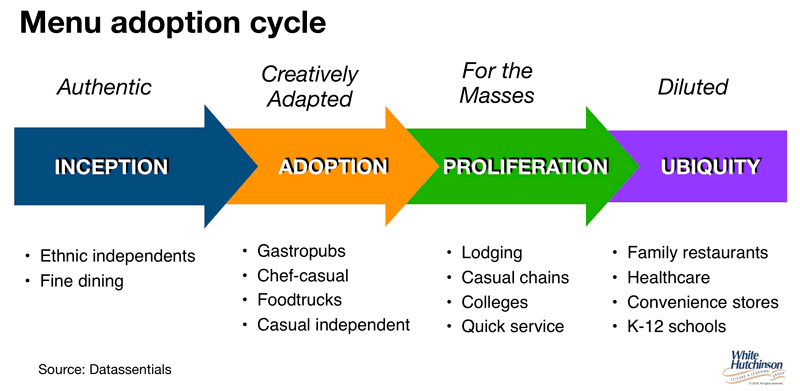
Vol. XVIII, No. 3, April 2018
- Editor's corner
- Follow tomorrow's food culture trends or be in peril
- Which generation spends the most on F&B away from home?
- Doc Brundy's nearing completion
- Skate to where the puck is going to be
- Who uses social media?
- Pinball renaissance
- Table 47 & Ocean5 now open
- Move over cows, here come the plants
- Update on the Tchotchke Index
Follow tomorrow's food culture trends or be in peril
As a design and production firm that works with community-leisure venues (CLVs) of all types including traditional family and children's entertainment centers, social-tainment and eatertainment centers, bowling-based projects and agritainment/agritourism farm venues, we assist our clients with their businesses from conception, to design to opening. This includes their food and beverage offerings - basically what is called restaurant and bar design. Design encompasses far more than the design of the physical kitchen and bar, seating areas and its associated FF&E. Our design work includes development of the food and drink menu, as you really have to develop it before you can properly design the F&B facilities and equipment.
Menu development requires us to stay on top of restaurant, drink and bar macro trends. We live in a fast-moving world. The culture of food is rapidly changing, far faster than just a decade ago. We are seeing accelerating food culture adoption.
Some of our CLV projects take years to design, develop and open. That means decisions made today won't see the light of day until sometime in the future. If the menu decisions are based on today's food culture and preferences, the menu is likely to be out of date by the time the CLV opens. This means you can't just look at today's preferences and trends. You need to predict what food trends and food culture will be when you open the CLV - what will be the sweet spot for the food service concept. Otherwise your menu, maybe the entire concept, will be out of date
Food trends follow a common life cycle through four distinct stages - the Menu Adoption Cycle.

Historically food trends generally took 12 years to move through the entire Menu Adoption Cycle. Today that cycle time has been roughly cut in half to six years.
There are multiple influences that are accelerating food trends including:
- A growing ethnic population bringing with it greater interest in trending foods and flavors and exposing other Americans to these foods and flavors.
- Ethnic consumers who are also becoming more acculturated, bringing their food preferences to restaurants.
- The migration of more consumers to dense city centers where they get more exposure to new foods, causing trends to be adopted at a faster rate
- The prevalence foodie-ism and its associated rising expectations driven by food shows, food blogs and the elevation of food experiences as a social driver
- Mobile app technology including Instagram, Pinterest, Yelp and OpenTable let consumers share their food experiences faster than ever.
The sweet spot of the American consumer's appetite used to be at the Proliferation stage - safe, mainstream foods that are at most slightly progressive. Now the sweet spot is changing to one stage earlier to Adoption - adventurous dining, discovering new foods and flavors, including ethnic foods, even street foods. That stage now evolves from the beginning of its Inception stage in just a few years.

Exhibition kitchen at Table 47, the destination restaurant that is part of the
Ocean5 eatertainment project we've been working on for 10 years
opened
April 8th.
The fast-moving Menu Adoption Cycle is just one example of why our company spends extensive time researching and studying trends not only for food and drink, but also everything that impacts the design and operation of CLVs. See our article in this issue Skate to where the puck is going to be.
Vol. XVIII, No. 3, April 2018
- Editor's corner
- Follow tomorrow's food culture trends or be in peril
- Which generation spends the most on F&B away from home?
- Doc Brundy's nearing completion
- Skate to where the puck is going to be
- Who uses social media?
- Pinball renaissance
- Table 47 & Ocean5 now open
- Move over cows, here come the plants
- Update on the Tchotchke Index



